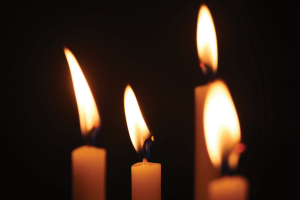On the road of life, it’s helpful to have an experienced navigator in the passenger seat.
Lunch lasted almost three hours. We talked about health care, the economy, books, movies, and grandchildren. At one time this group of friends belonged to the same parish. Though times have changed, we have remained close. They are my dearest friends who have supported me through struggles, illness, and even the death of my husband.
Nevertheless, there is one area that never comes up in the conversation—my prayer life, that place where I “live and move and have my being.”
Shortly before this lunch I had come to a deeper understanding of a blessing, an answer to prayer received 20 years ago. After all that time I suddenly understood that the gift was not just for me and my family. Instead I saw it flowing on for years, blessing other people, who I hope had passed it on beyond people I knew or could imagine. I was brought to tears, full of gratitude, and filled with a gentle sense of peace and a quiet joy.
Obviously my friends care about me, but I’ve learned that sharing such experiences are non sequiturs in our conversations over lunch. Who will hear and understand this story? The answer: my spiritual director.
Many years ago, I noticed that my prayer life was changing dramatically. I explored different forms of prayer. I started to go to daily Mass. I wanted to talk to someone about it, but I didn’t know whom.
Finally, on a retreat, I found a spiritual director. At last, here was someone who could explain what was happening and tell me exactly what to do. Isn’t that what the word “direction” implies? But in this case “direction” is a bit of a misnomer. A more apt title would be “soul friend” or “spiritual companion.” Instead of answers, I learned to live with the questions through my meetings with my director. The Holy Spirit works slowly, and the answers are not given until we are ready.
Spiritual direction is an invitation to come and see. I am reminded of the two future disciples of Jesus who were curious and asked him, “Where do you live?” Jesus replied, “Come and see” (John 1:35-39). Through spiritual direction I learned to reflect on how and where God appears in my life. He was not only in the Eucharist, in nature, and in the people I love, but in the office, in the homeless person on the street corner, in my everyday routine, and even in my struggles.
Trappist monk Thomas Merton wrote, “There is only one problem on which all my existence, my peace and my happiness depend: to discover myself in discovering God. If I find him I will find myself, and if I find my true self, I will find him.”
The problem is that most often we become aware of God’s presence only after the fact. God said to Moses, “You cannot see my face” (Exod. 35:20). But then God told Moses that he could see his back: “You will see me pass.”
Like Moses, we discover God only after he has passed by. Spiritual direction sets aside a sacred time and space for such discovery. In the case of my recent discovery, it took 20 years.
In the Christian tradition, we often trace spiritual direction to the ancient desert fathers and mothers. In the third century men and women left the noisy crowds of the city for the desert in order to find space and time to contemplate, to search for God. They attracted many pilgrims who came for advice.
In the seventh and eighth centuries the Irish monks had “soul mates,” another monk who would listen, pray, advise, and encourage. They, too, attracted people from the villages who wanted to deepen their relationships with God. Today spiritual direction is practiced by priests, religious, and laypeople, both men and women.
Spiritual direction is not counseling. Counseling tries to solve problems by understanding life history, by recognizing destructive patterns of behavior, or by modifying ways of making decisions. Spiritual direction is not for solving problems or making decisions in a time of crisis. All of this may be done without any mention of the presence of God. Instead, spiritual direction is about all areas of life and how the mystery of God’s presence is revealed in all our experiences.
The purpose of spiritual direction is developing and deepening a relationship with God. While not the same as the sacrament of reconciliation, it invites an honest look at the self. Failings are revealed in that light of love. As we grow and deepen the relationship with God, our self-image changes and so does our image of God. We become aware that God is the potter; we are the clay. What changes is our awareness of God.
There is nothing quite so sacred, or so mysterious, as a person’s journey toward God. Spiritual direction receives and holds this mystery. Time and place are sanctified. Two have gathered in his name, and Christ is truly present.
Asking for direction
The spiritual direction relationship is professional, and everything is strictly confidential, so finding a director requires the same care as choosing a counselor or therapist. Pray and ask God for guidance. Ask your pastor if he has any recommendations, or see if there is a local retreat center with a list of directors. Ask for several names and plan to interview more than one director.
Check the website of Spiritual Directors International (sdiworld.org), which provides a list of members by region or city. It also has a list of questions that would be helpful for you at the initial interview.
Before scheduling an initial meeting, find out about location, fees, and whether a director is accepting new directees. In the initial meeting, both you and the director will be asking the same questions: Is this a good fit? Do your expectations match?
After the interview, ask yourself: Were your questions answered? Do you feel he or she has listened and understood you? Would you feel comfortable sharing life experiences with this director? Do not feel obligated to any director that you interview; similarly, do not be offended if the director decides not to accept you for direction.
Take your time, pray. This is an important decision. It may be life-changing!
This article appeared in the July 2010 issue of U.S. Catholic (Vol. 75, No. 7, pages 47-48).














Add comment